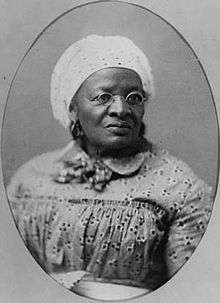Mary Meachum

Mary Meachum (1801–1869) was an American abolitionist who, with her husband John Berry Meachum, helped enslaved people escape to freedom in the Underground Railroad, and by purchasing their freedom. The Mary Meachum Freedom Crossing in St. Louis, the first site in Missouri to be accepted in the National Park Service's National Underground Railroad Network to Freedom, was named after her.
Early life and marriage
Meachum was born into slavery in Kentucky. While still enslaved, she married John Berry Meachum, who had already purchased his own freedom with money he had earned as a carpenter. In 1815, Mary Meachum's owner took her to St. Louis, Missouri. Her husband followed and purchased her freedom shortly afterwards. The Meachums ran a school for free and enslaved black people in the First African Baptist Church, which they later moved to a floating steamboat on the Mississippi River when the state of Missouri banned education for blacks in 1847. They also used the proceeds from John Berry Meachum's carpentry and barrel-making business to purchase freedom for twenty enslaved individuals.[1]
Mary Meachum's profession was listed as 'milkmaid' in 1835.[2]
Arrest and trial

After John Berry Meachum died in 1854, Mary Meachum continued running their home on Fourth Street as a 'safe house' on the Underground Railroad. On May 21, 1855, after an attempt to ferry nine enslaved people across the Mississippi River to freedom in Illinois, Meachum and a freedman named Isaac were arrested for breaking the Fugitive Slave Law of 1850.[3] On May 24, 1854, she was charged in court with slave theft, while charges against Isaac were dropped.
The Missouri Republican reported on July 19, 1855 that Mary was tried by a jury and acquitted of at least one charge, and the remaining charges were dropped.[4]
The Colored Ladies Soldiers' Aid Society
One scholar says Meachum was sold into slavery in Vicksburg, Mississippi, after her arrest.[5] However, the Daily Missouri Democrat reported on December 17, 1864, that Meachum was at that time president of the Colored Ladies Soldiers' Aid Society in St. Louis.[6] This organization of free black women, also called the Colored Ladies Contraband Society, was formed in 1863 to assist black Union soldiers and escaped slaves in St. Louis during the Civil War. Because blacks were not allowed to ride streetcars at that time, the women negotiated with the streetcar company to ride the streetcar one day a week, on Saturdays, to the segregated wing of the Benton Barracks Hospital of St. Louis, where wounded black soldiers were hospitalized. There, the women read to the soldiers, comforted them, and taught them to read. The white nurse in charge of the hospital, Emily Parsons, wrote of her outrage that the women were limited to only one day a week and described them as "intelligent colored women, ladies in fact, many of them well educated and wealthy."[7]
Death
Meachum died in St. Louis in August, 1869.[8] She is buried in Bellefontaine Cemetery in St. Louis.[9]
Mary Meachum Freedom Crossing

The Mary Meachum Freedom Crossing, part of the National Park Service's National Underground Railroad Network to Freedom, was dedicated, Nov 1, 2001, in a special ceremony on the Riverfront Trail. Since then, it has hosted the annual Mary Meachum Freedom Crossing Celebration, an event which includes re-enactments of Mary Meachum's river crossing and arrest. The site is located just north of the Merchants Bridge in St. Louis.[10] In 2014, plans were underway to expand the site to a national historical monument to the Underground Railroad, which would include interpretive towers, a wall of names, and healing gardens.[11][12]
References
- ↑ Snodgrass, M.E. (2015). The Underground Railroad: An Encyclopedia of People, Places, and Operations. Taylor & Francis. p. 361. ISBN 9781317454168. Retrieved November 1, 2015.
- ↑ Lea Vandervelde, Redemption Songs: Suing for Freedom Before Dred Scott, Oxford University Press, 2014, ISBN 0199927294
- ↑ "Mary Meachum and The Underground Railroad, St. Louis Public Radio, Oct. 9, 2012". stlpublicradio.org. Retrieved November 1, 2015.
- ↑ VanderVelde, L. (2009). Mrs. Dred Scott: A Life on Slavery's Frontier. Oxford University Press. ISBN 9780199887859. Retrieved November 1, 2015.
- ↑ Snodgrass, The Underground Railroad: An Encyclopedia of People, Places and Operations, Introduction, p. xxxi
- ↑ Daily Missouri Democrat, December 17, 1864. Cited in Sharon Elizabeth Romero, Freedwomen in Pursuit of Liberty, University of Iowa, 2009
- ↑ Jeannie Attie, Patriotic Toil: Northern Women and the Civil War, Cornell University Press, 1998
- ↑ "Missouri Wills and Probate Records, 1766-1988, Case #8900, 1869". interactive.ancestry.com. Retrieved November 1, 2015.
- ↑ "Mary Meachum - Find-A-Grave". findagrave.com. Retrieved November 1, 2015.
- ↑ "Mary Meachum Freedom Crossing Celebration"
- ↑ "Land Swap Moves Mary Meachum Site Memorial Forward, St. Louis Post-Dispatch, 2014". stltoday.com. Retrieved November 1, 2015.
- ↑ "Group floats multimillion-dollar plan for Underground Railroad site in St. Louis : St. Louis Post Dispatch, 2014". stltoday.com. Retrieved November 1, 2015.